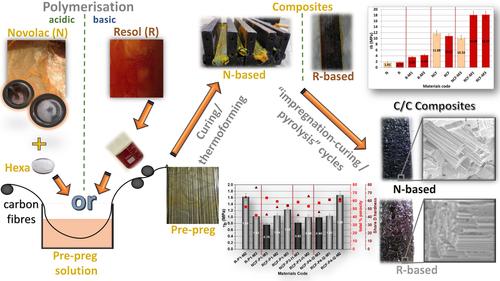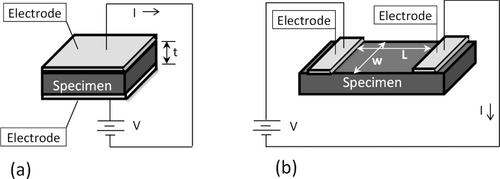下载PDF
{"title":"Performance of novolac resin- and resole resin-based carbon/carbon composites in relation to their fabrication conditions","authors":"Pantelitsa Georgiou, Eleftheria Kyriakopoulou, Loukas Zoumpoulakis","doi":"10.1002/pi.6637","DOIUrl":null,"url":null,"abstract":"<p>The demands of cost-driven industrial applications can be satisfied by manufacturing composites with a low volume fraction of carbon fibres as phenolic carbon fibre-reinforced composites and C/C composites, both with acceptable performances, for low- or high-temperature applications, respectively. Polymeric composites reinforced with a low volume fraction (7.5% v/v) of carbon fibres were fabricated using laboratory-produced phenolic resins, novolac (N) and resole (R), as matrices after different curing/post-curing temperature profiles. By optimising the manufacturing conditions, the N-based polymeric composites exhibited higher flexural strength, whereas the R-based composites showed higher shear strength. C/C composites, namely N-based and R-based, were manufactured by pyrolysis of the previously prepared polymeric composites up to 1000 °C. The pyrolysed composites were then densified by impregnation with an appropriate resin solution, followed by curing and new pyrolysis, and particularly by employing 1 up to 4 consecutive cycles of ‘impregnation–curing/pyrolysis’. Weight changes resulting from the impregnation–curing and pyrolysis stages were determined. The curing of both resins was verified by Fourier Transform Infrared Analysis. The apparent density and X-ray diffraction data of the C/C composites were used to calculate their total percent porosities. The morphology and elemental composition of the C/C composites at their failure region (after flexural testing) were examined by Scanning Electron Microscopy/Energy-Dispersive X-ray Analyses. In comparison to the N-based C/C composites, the R-based ones exhibited: higher shear strength, lower flexural strength, higher Shore D hardness, slightly higher surface conductivity and lower volume conductivity. The optimum conditions for the manufacture of C/C composites were achieved by applying two consecutive cycles of ‘pyrolysis–impregnation–pyrolysis’ to the polymeric composites. © 2024 The Authors. <i>Polymer International</i> published by John Wiley & Sons Ltd on behalf of Society of Industrial Chemistry.</p>","PeriodicalId":20404,"journal":{"name":"Polymer International","volume":"73 8","pages":"658-672"},"PeriodicalIF":2.9000,"publicationDate":"2024-04-02","publicationTypes":"Journal Article","fieldsOfStudy":null,"isOpenAccess":false,"openAccessPdf":"https://onlinelibrary.wiley.com/doi/epdf/10.1002/pi.6637","citationCount":"0","resultStr":null,"platform":"Semanticscholar","paperid":null,"PeriodicalName":"Polymer International","FirstCategoryId":"92","ListUrlMain":"https://onlinelibrary.wiley.com/doi/10.1002/pi.6637","RegionNum":4,"RegionCategory":"化学","ArticlePicture":[],"TitleCN":null,"AbstractTextCN":null,"PMCID":null,"EPubDate":"","PubModel":"","JCR":"Q2","JCRName":"POLYMER SCIENCE","Score":null,"Total":0}
引用次数: 0
引用
批量引用
Abstract
The demands of cost-driven industrial applications can be satisfied by manufacturing composites with a low volume fraction of carbon fibres as phenolic carbon fibre-reinforced composites and C/C composites, both with acceptable performances, for low- or high-temperature applications, respectively. Polymeric composites reinforced with a low volume fraction (7.5% v/v) of carbon fibres were fabricated using laboratory-produced phenolic resins, novolac (N) and resole (R), as matrices after different curing/post-curing temperature profiles. By optimising the manufacturing conditions, the N-based polymeric composites exhibited higher flexural strength, whereas the R-based composites showed higher shear strength. C/C composites, namely N-based and R-based, were manufactured by pyrolysis of the previously prepared polymeric composites up to 1000 °C. The pyrolysed composites were then densified by impregnation with an appropriate resin solution, followed by curing and new pyrolysis, and particularly by employing 1 up to 4 consecutive cycles of ‘impregnation–curing/pyrolysis’. Weight changes resulting from the impregnation–curing and pyrolysis stages were determined. The curing of both resins was verified by Fourier Transform Infrared Analysis. The apparent density and X-ray diffraction data of the C/C composites were used to calculate their total percent porosities. The morphology and elemental composition of the C/C composites at their failure region (after flexural testing) were examined by Scanning Electron Microscopy/Energy-Dispersive X-ray Analyses. In comparison to the N-based C/C composites, the R-based ones exhibited: higher shear strength, lower flexural strength, higher Shore D hardness, slightly higher surface conductivity and lower volume conductivity. The optimum conditions for the manufacture of C/C composites were achieved by applying two consecutive cycles of ‘pyrolysis–impregnation–pyrolysis’ to the polymeric composites. © 2024 The Authors. Polymer International published by John Wiley & Sons Ltd on behalf of Society of Industrial Chemistry.
酚醛树脂和树脂基碳/碳复合材料的性能与制造条件的关系
通过制造碳纤维体积分数较低的酚醛碳纤维增强复合材料和 C/C 复合材料,可以满足成本驱动型工业应用的需求,这两种材料的性能均可接受,可分别用于低温或高温应用。使用实验室生产的酚醛树脂、酚醛(N)和酚醛(R)作为基材,经过不同的固化/后固化温度曲线,制造出了低体积分数(7.5% v/v)碳纤维增强的聚合物复合材料。通过优化制造条件,N 基聚合物复合材料表现出更高的抗弯强度,而 R 基复合材料则表现出更高的剪切强度。C/C 复合材料,即 N 基和 R 基复合材料,是通过将之前制备的聚合物复合材料热解至 1000 ℃ 而制成的。然后用适当的树脂溶液对热解后的复合材料进行浸渍、固化和新的热解,特别是采用 1 至 4 次连续的 "浸渍-固化-热解 "循环,使其致密化。对浸渍-固化和热解阶段产生的重量变化进行了测定。傅立叶变换红外分析验证了两种树脂的固化情况。C/C 复合材料的表观密度和 X 射线衍射数据用于计算其总孔隙率。扫描电子显微镜/能量色散 X 射线分析法检测了 C/C 复合材料失效区(弯曲测试后)的形态和元素组成。与 N 基 C/C 复合材料相比,R 基复合材料表现出:较高的剪切强度、较低的弯曲强度、较高的邵氏 D 硬度、稍高的表面传导率和较低的体积传导率。通过对聚合物复合材料进行两个连续的 "热解-浸渍-热解 "循环,达到了制造 C/C 复合材料的最佳条件。© 2024 作者。国际聚合物》由 John Wiley & Sons Ltd 代表工业化学学会出版。
本文章由计算机程序翻译,如有差异,请以英文原文为准。




